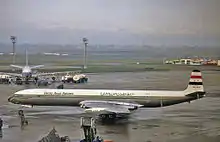United Arab Airlines Flight 869 (1963)
United Arab Airlines Flight 869 was an international scheduled passenger de Havilland Comet 4C flight from Tokyo, Japan, to Cairo via Hong Kong, Bangkok, Bombay and Bahrain.[1][2] On 28 July 1963 it was being operated by a de Havilland Comet registered as SU-ALD, when on approach to Bombay's Santa Cruz Airport it crashed into the Arabian Sea off Bombay on 28 July 1963 with the loss of all 63 passengers and crew on board.[1][2] Among the 55 passengers was the Philippine delegation of 24 Boy Scouts and adults traveling to the 11th World Scout Jamboree in Greece.[3]
 A de Havilland DH.106 Comet of United Arab Airlines, similar to the crashed aircraft | |
| Accident | |
|---|---|
| Date | 28 July 1963 |
| Summary | Loss of control in turbulent weather |
| Site | In the sea 10 km (6.2 mi) from Bombay Airport, India |
| Aircraft | |
| Aircraft type | de Havilland Comet 4C |
| Operator | United Arab Airlines |
| Registration | SU-ALD |
| Flight origin | Tokyo International Airport, Tokyo, Japan |
| 1st stopover | Kai Tak Airport, Hong Kong |
| 2nd stopover | Don Mueang International Airport, Bangkok, Thailand |
| 3rd stopover | Bombay – Santa Cruz Airport, Bombay, India |
| Last stopover | Bahrain International Airport, Manama, Bahrain |
| Destination | Cairo International Airport, Cairo, Egypt |
| Passengers | 55 |
| Crew | 8 |
| Fatalities | 63 |
| Injuries | 0 |
| Survivors | 0 |
Accident
At 1:46 a.m. in Mumbai on 28 July 1963 (20:16 GMT on 27 July), the Comet crew reported being overhead the Santa Cruz VOR beacon at 7000 feet and were cleared to descend to 4000 feet.[2] The crew requested an Instrument Landing System approach to Runway 09 and that they would follow the back beam procedure.[2] The controller advised them the procedure was not available and they should carry out an approach using the VOR beacon.[2] The crew agreed to use the procedure and reported leaving 7000 feet in the descent on the 272-degree radial from the VOR.[2] The controller advised them that they might encounter heavy turbulence if they went more than six or seven miles west of the airport.[2] The crew requested a left-hand procedure rather than the more normal right-hand one because of the weather.[2] Permission was granted and the aircraft, already in severe turbulence, entered a left-hand turn and then crashed into the sea at 1:50 a.m., nine nautical miles from Madh Island.[2]
Probable cause
Because no wreckage was salvaged and the crew did not report any problems, it was concluded that the aircraft was probably lost due to loss of control while turning in severe turbulence and heavy rain.[2]
References
- Accident description at the Aviation Safety Network
- Civil Aviation Authority 1974, p. 14/63
- "Airliner Crash in Sea Near Bombay – Scouts Among 62 on Board, Search For Bodies". News. The Times (55765). London. 29 July 1963. col D, p. 10.
| Wikimedia Commons has media related to United Arab Airlines Flight 869 (1963). |
Bibliography
- World Accident Summary. Civil Aviation Authority (United Kingdom). 1974. ISBN 0-903083-44-2.